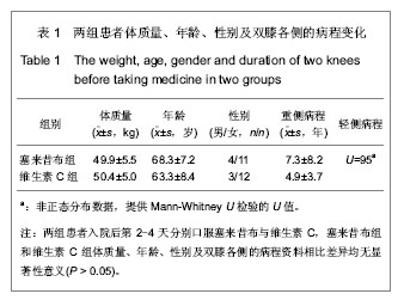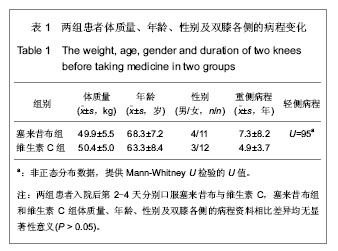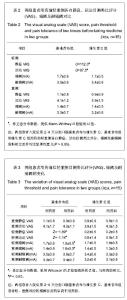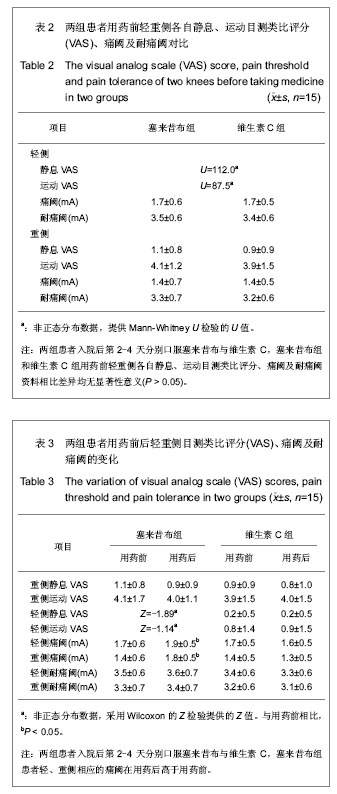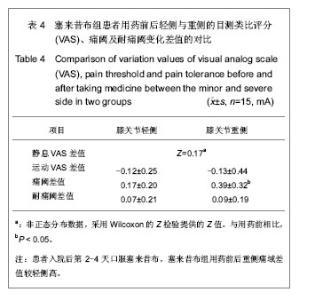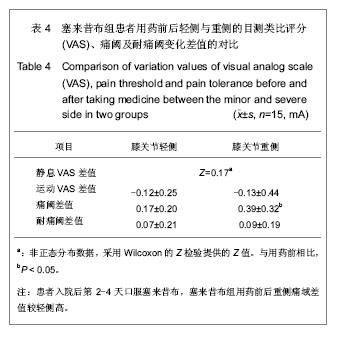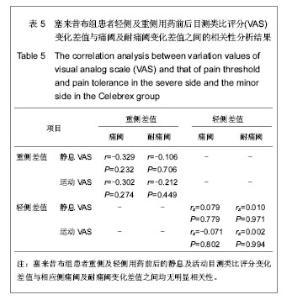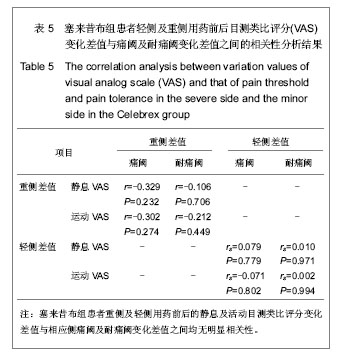| [1] 朱小兰.膝关节置换置换后疼痛的护理[J].中国农村卫生,2013, (z2):213.[2] Katz J, Clarke H, Seltzer Z. Review article: Preventive analgesia: quo vadimus?. Anesth Analg. 2011;113(5): 1242-1253.[3] Nielsen PR, Norgaard L, Rasmussen LS, et al. Prediction of post-operative pain by an electrical pain stimulus. Acta Anaesthesiol Scand. 2007;51(5):582-586.[4] Hsu YW, Somma J, Hung YC, et al. Predicting postoperative pain by preoperative pressure pain assessment. Anesthesiology. 2005;103(3):613-618.[5] 中华医学会骨科学分会.骨关节炎诊治指南(2007年版)[J].中华骨科杂志,2007,27(10):793-796.[6] 蒋云华,蔡军.美国国家临床化学科学院2011年关于诊断和处理糖尿病的实验室检查的建议和指南[J].实用检验医师杂志,2011, 3(3):172-173, 183.[7] 郭春芳,陈晴燕.银屑病的诊断和鉴别诊断[J].中国实用乡村医生杂志,2011,18(12):3-4.[8] Daabiss M. American Society of Anaesthesiologists physical status classification. Indian J Anaesth. 2011;55(2):111-115.[9] 王宁华.疼痛定量评定的进展[J].中国临床康复,2002,6(18): 2738-2739.[10] 赵巍峰,杨文辉,梁敉宁,等.抑郁症患者的痛阈及其相关因素研究[J].中华行为医学与脑科学杂志,2009,18(6):484-486.[11] Chesterton LS, Barlas P, Foster NE, et al. Gender differences in pressure pain threshold in healthy humans. Pain. 2003;101 (3): 259-266.[12] Helme RD, Meliala A, Gibson SJ. Methodologic factors which contribute to variations in experimental pain threshold reported for older people. Neurosci Lett. 2004;361(1-3): 144-146.[13] Azevedo E, Manzano GM, Silva A, et al. The effects of total and REM sleep deprivation on laser-evoked potential threshold and pain perception. Pain. 2011;152(9):2052-2058.[14] Chiu YH, Silman AJ, Macfarlane GJ, et al. Poor sleep and depression are independently associated with a reduced pain threshold. Results of a population based study. Pain. 2005; 115(3):316-321.[15] Meerlo P, Koehl M, van der Borght K, et al. Sleep restriction alters the hypothalamic-pituitary-adrenal response to stress. J Neuroendocrinol. 2002;14(5):397-402.[16] Suzuki K, Maekawa K, Minakuchi H, et al. Responses of the hypothalamic-pituitary-adrenal axis and pain threshold changes in the orofacial region upon cold pressor stimulation in normal volunteers. Arch Oral Biol. 200;52(8):797-802.[17] Klauenberg S, Maier C, Assion H J, et al. Depression and changed pain perception: hints for a central disinhibition mechanism. Pain. 2008;140(2):332-343.[18] Goldstein DJ, Lu Y, Detke M J, et al. Effects of duloxetine on painful physical symptoms associated with depression. Psychosomatics. 2004;45(1):17-28.[19] Fardal O, Mcculloch CA. Impact of anxiety on pain perception associated with periodontal and implant surgery in a private practice. J Periodontol. 2012;83(9):1079-1085.[20] Colloca L, Benedetti F. Nocebo hyperalgesia: how anxiety is turned into pain. Curr Opin Anaesthesiol. 2007;20(5):435-439.[21] Aasvang EK, Hansen JB, Kehlet H. Can preoperative electrical nociceptive stimulation predict acute pain after groin herniotomy? J Pain. 2008;9(10):940-944.[22] Pan PH, Coghill R, Houle TT, et al. Multifactorial preoperative predictors for postcesarean section pain and analgesic requirement. Anesthesiology. 2006;104(3):417-425.[23] Granot M, Lowenstein L, Yarnitsky D, et al. Postcesarean section pain prediction by preoperative experimental pain assessment. Anesthesiology. 2003;98(6):1422-1426.[24] Poobalan AS, Bruce J, Smith WC, et al. A review of chronic pain after inguinal herniorrhaphy. Clin J Pain. 2003;19(1): 48-54.[25] Aasvang EK, Brandsborg B, Christensen B, et al. Neurophysiological characterization of postherniotomy pain. Pain. 2008;137(1):173-181.[26] Bjordal JM, Ljunggren AE, Klovning A, et al. Non-steroidal anti-inflammatory drugs, including cyclo-oxygenase-2 inhibitors, in osteoarthritic knee pain: meta-analysis of randomised placebo controlled trials. BMJ. 2004;329(7478):1317.[27] Valdes AM, Loughlin J, Timms KM, et al. Genome-wide association scan identifies a prostaglandin-endoperoxide synthase 2 variant involved in risk of knee osteoarthritis. Am J Hum Genet. 2008;82(6):1231-1240.[28] Adatia A, Rainsford KD, Kean WF. Osteoarthritis of the knee and hip. Part I: aetiology and pathogenesis as a basis for pharmacotherapy. J Pharm Pharmacol. 2012;64(5):617-625.[29] 张磊.塞来昔布对膝骨关节炎滑膜组织环氧化酶2表达影响研究[D].北京:北京协和医学院.2012. |
